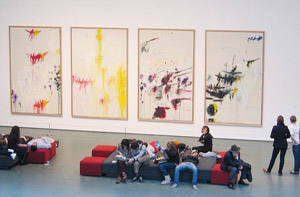Cy Twombly
Edwin Parker “Cy” Twombly, Jr. was born in Lexington, Virginia in April 1928. Born under the sign of Taurus he bore many traits attributed to the star sign. Taureans typically are astute, highly dominant, strong, stubborn and observant. He is known for his graffiti-style painting and large-scale works such as “The Four Seasons” and “Fifty Days at Iliam”. Internationally regarded, his work was soon acquired for the permanent collections of the Museum of Modern Art in New York and the’ Musée du Louvre in Paris.
His odd nickname “Cy” was given to Twombly by his father who also bore the nickname Cy. They were named after a famous pitcher who played for the Red Sox, Indians and Braves and the Cardinals. Twombly Jrs father was also a pitcher for the Chicago White Sox.
At the age of 12, Cy Twombly became a student of the Spanish artist Pierre Daura and subsequently attended the School of the Museum of Fine Arts in Boston and Virginia’s Washington and Lee University.
In 1950, Cy Twombly went to New York where he met Robert Rauschenberg and studied at the Art Students League and shared a studio with Rauschenberg. He began a relationship with Rauschenberg who encouraged him to study in North Carolina at Black Mountain College where he studied with Robert Motherwell, Franz Kline and Ben Shahn. 1952 saw Twombly and Rauschenberg travel to North Africa, Spain, Italy and South America.

He was greatly inspired by Roman and Greek architecture, mythology and history along with contemporary graffiti and French Neo-classicism. Moving to Rome in 1957 Twombly’s work reflected Greco Roman history and he gathered inspiration from his surroundings. He remained in Rome for the rest of his life and was married to the sister of his patron Baron Giogio Franchetti. Twombly was wed to Baroness Tatiana Franchetti also an artist at City Hall, New York in 1959. They returned to Italy after buying a palazzo in Rome but later moved to Gaeta near Rome. It was here that Twombly became more reclusive as the years passed.
The words Cy Twombly inscribed on paintings were often the names of figures in mythology and closer contact with classics led him to produce a cycle of works based on myths including “The Birth of Venus” and Leda and the Swan”. He returned to these subjects painting them many times over the years.
He produced a number of works on grey backgrounds referred to as the “gray paintings” which were just colourless scrawls that form no words. These works were created sitting upon a friend’s shoulders who went side to side across the canvas length allowing Twombly to paint continuous, fluid lines.

In the 1980s and 90s, Twombly took interest in painting flowers. These works have a sombre almost funereal quality. It is as though the pictures are a memorial to the dead. He painted many instances of the Empyrean rose from Dante’s Paradiso, embodied as the fusion of human and divine love.
In 2011, Cy Twombly was hospitalized for several days in Rome. He had suffered for many years with cancer and died of his illness. He is survived by his son, Cyrus Alessandro Twombly, also an artist who lives in in Rome and his long-time companion Nicola Del Roscio.
